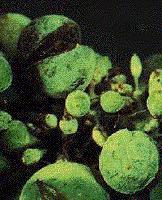Warning long post!
Some following words are a struggle, but they make GREAT google search terms when you are struggling with a garden problem like how to impact this disease organically.
We have an easier time fighting off attacks that are on the outside of a plant. This late blight has the ability to get inside and without something systemic to stop it, the party is over quickly. This is why I will pull out agri-fos when it gets bad. I have not found better. This family of pathogens even attacks fish. I was fascinated to read the following from the Berkeley website:
Water molds were once thought to be fungi.
The Oomycota were once classified as
fungi, because of their filamentous growth, and because they feed on decaying matter like fungi. The cell wall of oomycetes, however, is not composed of chitin, as in the fungi, but is made up of a mix of
cellulosic compounds and glycan. The nuclei within the filaments are
diploid, with two sets of genetic information, not haploid as in the fungi.
The ultrastructure, biochemistry, and molecular sequences of these organisms indicate that they belong with the
Chromista. The free-swimming spores which are produced bear two dissimilar flagella, one with
mastigonemes; this feature is common in the chromists, as is the presence of the chemical
mycolaminarin, an energy storage molecule similar to those found in kelps and diatoms. Thus, although oomycetes are in the minority as heterotrophic chromists, they quite definitely belong with these other chromist groups.
Parasitic water molds damage fish and many crop plants.
Some water molds are
parasites on other organisms; they may grow on the scales or eggs of
fish, or on amphibians. The water mold
Saprolegnia causes lesions on fish which cause problems when the water is rather stagnant, as in aquaria or fish farms, or at high population densities, such as when salmon swim upstream to spawn. Other species of
Saprolegnia are parasitic on aquatic invertebrates such as rotifers, nematodes, and arthropods, and on diatoms.
Their greatest impact on humans, however, comes from the many species of water mold which are parasites on flowering plants. These include root rotting fungi, seedling dampening mold, blister rusts, white rusts (
Albugo), and the downy mildews that affect grapes, lettuce, corn, cabbage, and many other crop plants. Two of these disease-causing chromists have had a major impact on world history.
The first of these is
Phytophthora infestans, the organism which causes late blight of potato. The potato is native to North America, but once it was introduced to Europe, it quickly became an important food crop. Late blight did not follow its host plant across the Atlantic until much later; the disease organism grows into the stem and leaf tissues, causing death, and may also infest the
tubers, which are the part of the plant that is eaten. The disease spreads rapidly under cool and damp conditions, which are common in western Europe. In one week during the summer of 1846, this diease wiped out almost the entire potato crop of Ireland, a crop which was the primary food of the poor at that time. Nearly a million Irish died in the
Great Famine, and an additional one-and-a-half million emigrated to other countries, including America. Thus, if you are an American with Irish ancestry, it was probably the oomycetes that brought your family here. Other species of
Phytophthora destroy eucalyptus, avocado, pineapples, and other tropical crop plants.

The other oomycete which has severely impacted recent history is pictured at right --
Plasmopara viticola, the downy mildew of grapes. It also is a native of North America, but in the late 1870s was accidentally introduced to Europe. At the time, the French wine industry was concerned over a massive aphid infestation, and so brought resistant vine strains over from America to breed them into their own grapes. When these American stocks arrived, they also brought the downy mildew, which almost wiped out the entire French wine industry. The industry was saved by the serendipitous discovery of Bordeaux mixture, a mixture of lime and copper sulfate, which brought the disease under control when applied to the leaves of the plants. This discovery is also important for being the first known fungicide, and in fact the first chemical used to control a plant disease.







